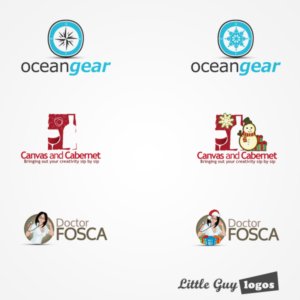Leveraging the Holidays to Market Your Brand
Whether liked or not, the entire holiday season remains the most important time of the year for both brands and consumers. Even though Black Friday and Cyber Monday are the two largest shopping days of the year, the opportunity to generate monumental profits exists long after. During this time many consumers are open and willing to try new brands. Companies with strong brand equity have greater ability to capitalize on this opportunity. Leveraging the holidays to market your brand can set you ahead of the competition now and even after the season is over.
Optimize Your Site
Site optimization for the holidays can be done in many ways. The first is by adding holiday-themed graphics to your site. Consider things such as:
- Updating your logo with festive detail
- Use “holiday” or “winter” colors across your site
- Creating a banner
- Shape special offers as gift boxes
Here are some examples:

Source: Little Guy Logos
Next, make sure your payment process is smooth and streamlined. Make your payment process as simple as possible. Consumers don’t appreciate when it’s difficult to add something to their cart or a lengthy checkout process. Make sure your payment system is as polished as possible before it’s too late. There should also be diversity in your payment options. If you already offer a variety of credit card and PayPal payments, consider adding Apple Pay if you haven’t already. Accepting all forms of payment may put you a leg up from your competition.
Lastly, make sure you’re paying attention to site speed and mobile-friendliness. Page load time is always important, but especially this time of year. Consumers have even less time and patience than usual. They’re not going to stick around for a slow site when they can probably find the same thing elsewhere. This is especially important if you do decide to add holiday decorations and graphics to your site. Make sure you A/B test everything to ensure it’s not slowing your site. Delivering mobile-friendliness is also crucial this time of year. If you haven’t already shifted your focus to responsive design, it’s unlikely you’ll be able to pull that off before the end of the holidays. But better late than never, and it’s something to keep in mind for next year.
Utilize Social Media
Engagement on social media is at its peak during the holidays. Brands should use that to their advantage by creating shareable content and interacting with other users as much as possible. Here are some ways you can increase engagement during the holidays:
- Contests: Create a holiday contest where users provide and share their own content with you for a chance to win products or deals. This is beneficial because you can in turn re-share their content on your own page, instead of always having to create your own.
- Video Content: Videos have the highest engagement rate out of any type of online content. If you have holiday commercials, that should definitely be shared on all social platforms. Consider creating different promotional videos for the holiday deals you’re offering as well.
- Tip Sharing: Content that focuses on pain points and solves customers’ problems has the opportunity to gain a lot of visibility because those are the kinds of things they’re directly searching for. Creating and sharing blog posts on those topics across all platforms brings best results.
- Interactive Campaigns: If your holiday marketing strategy has a particular theme or center subject, encourage followers to share similar content. For example, if your holiday commercial features a puppy, ask users to share with you pictures or videos of their own pets. This can create a cute thread that will attract the attention of those that may have not been aware of your brand.
Stay Cohesive and Maximize Reach
Your holiday strategy should be included in your off-page efforts as well. The main goal should be to maximize reach to potential customers and inform them about your products, services, promotions, etc. This can be done by offering bloggers or influencers your products for them to review on their platform. Work to get some of your content featured in related guides on other sites. Make some type of event for people in your niche. There are endless ways that this can be accomplished. It just takes some work and creativity. It’s also important to remember that not everyone is going to be onboard with your pitch. Don’t get discouraged if someone turns you down. There are a lot of people online. Just move on and keep pitching!
Final Thoughts
As the space becomes increasingly competitive, these strategies are most effective when started early. We are getting late into the season now, but this is something to keep in mind for next year. You can start building up your marketing strategies throughout the year to maximize reach and hopefully capture more consumers.
How Onimod Global Can Help
Even the best e-commerce sites can need help with digital marketing, especially around the busy season. At Onimod Global, we’re experts in all areas including SEM, SEO, social, web dev, automation, and analytics. With our expertise and unique cross-channel digital marketing campaign strategies, we can power entire corporate marketing departments, or provide custom solutions for local businesses. We are your 24/7, in-house marketing partner.
Learn more about what we do, take a look at some of our work, or start your conversation with us today!

